Gorontalo is home to a wide variety of bird species, ranging from endemic species to migratory species. The beautiful birds of Gorontalo are a delight to birdwatchers and anyone who appreciates nature.
From the amazing crested black macaques to the colorful birds of paradise, Gorontalo has something for everyone.
The mountain forests of Gorontalo are home to many endangered species, such as the Wallace’s Standardwing Bird of Paradise, and the nearby coastal areas provide excellent habitats for a wide variety of waterfowl.
The bird population of Gorontalo is a crucial part of the local ecology and provides a great opportunity for birdwatchers to observe and appreciate the natural beauty of the region.
1. Maleo
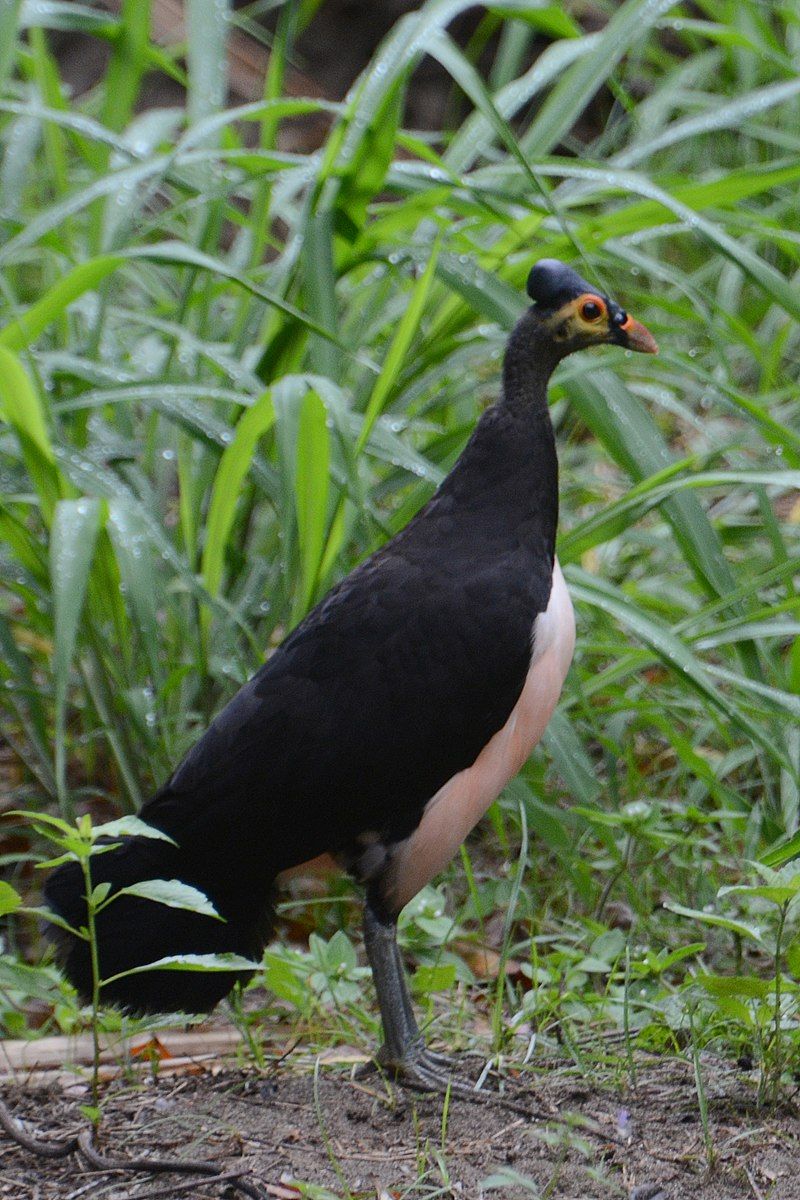
The maleo is a large, ground-dwelling bird that is the only species in its genus, Macrocephalon. This species is endemic to the Indonesian islands of Sulawesi and Buton. Maleos are megapodes, meaning they do not incubate their eggs with their body heat like other birds do.
Instead, they lay their eggs in the sand or in hot volcanic soils, which helps keep the eggs warm and allows them to hatch without the need for a parent. They are omnivorous, meaning they eat both plants and animals.
Maleos are considered a threatened species due to deforestation, hunting, and egg harvesting. Conservation efforts are in place to protect these birds and their habitat, but more needs to be done to ensure their long-term survival.
| Kingdom | Animalia |
| Phylum | Chordata |
| Class | Aves |
| Order | Galliformes |
| Family | Megapodiidae |
| Genus | Macrocephalon |
| Species | M. maleo |
2. Little Grebe
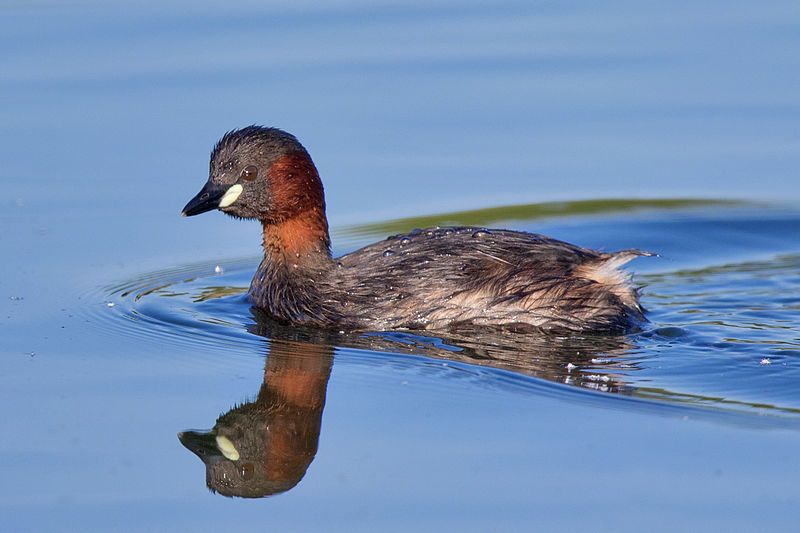
The little grebe, also known as a dabchick, is a water bird belonging to the grebe family. Its genus name, Takhus, comes from Ancient Greek and translates to “fast,” while bapto means “to sink under” in the same language.
The species, ruficollis, is derived from two Latin words: rufus meaning “red” and collis meaning “necked,” which itself is derived from collum meaning “neck.” This is likely in reference to the reddish neck feathers of the little grebe.
| Kingdom | Animalia |
| Phylum | Chordata |
| Class | Aves |
| Order | Podicipediformes |
| Family | Podicipedidae |
| Genus | Tachybaptus |
| Species | T. ruficollis |
3. Spotted Dove
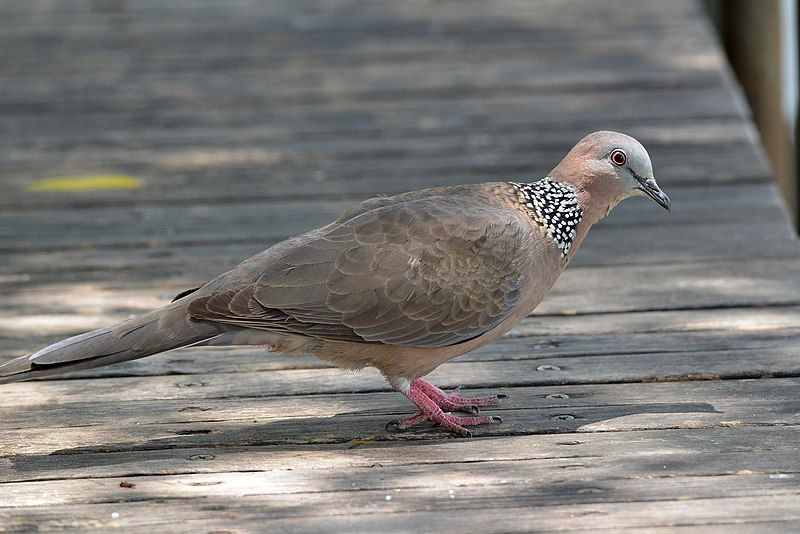
The spotted dove is a type of small, long-tailed pigeon that is natively found across the Indian subcontinent and Southeast Asia.
This species of bird is a common resident breeding bird, meaning that it will often return to the same nesting site year after year in order to reproduce.
In addition, the spotted dove has been introduced to many other areas of the world, and it has established itself in these new regions as well, forming feral populations.
This has enabled the species to spread its range across the globe, allowing it to become a more widespread species than it was before.
| Kingdom | Animalia |
| Phylum | Chordata |
| Class | Aves |
| Order | Columbiformes |
| Family | Columbidae |
| Genus | Spilopelia |
| Species | S. chinensis |
4. Blue-Breasted Quail
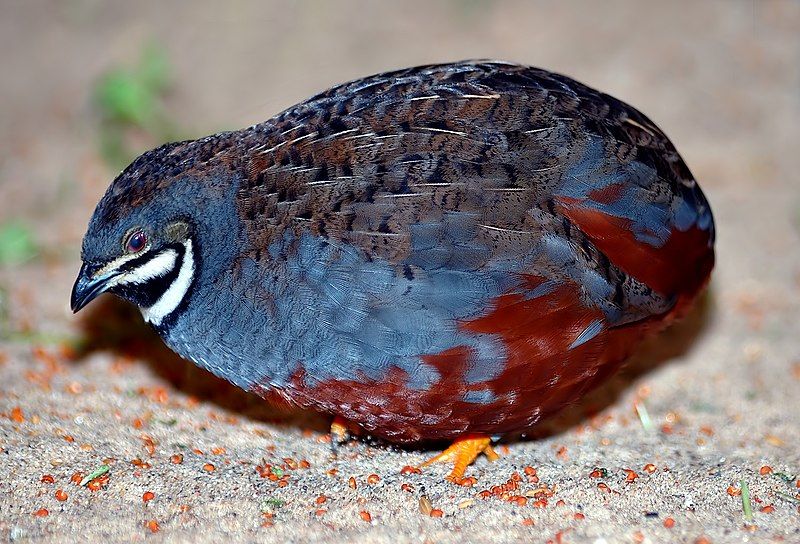
The King Quail is a species of quail from the Old World, belonging to the Phasianidae family. It is native to parts of Asia, and is also known by many other common names, including Blue-breasted Quail, Asian Blue Quail, Chinese Painted Quail, and Chung-Chi.
It is a small bird, typically measuring under ten inches in length and is characterized by its unique blue-colored chest and its multi-colored plumage on the wings and tail.
Its diet consists of a variety of seeds, insects, and other small creatures, and it is known to have an omnivorous diet. It is generally a solitary bird, and nests in small colonies, typically in grasslands or open woodlands.
It is a popular game bird and is hunted for its meat, eggs, and feathers. Its population is believed to be stable, and it is listed as Least Concern by the International Union for Conservation of Nature.
| Kingdom | Animalia |
| Phylum | Chordata |
| Class | Aves |
| Order | Galliformes |
| Family | Phasianidae |
| Genus | Synoicus |
| Species | S. chinensis |
5. Pacific Black Duck
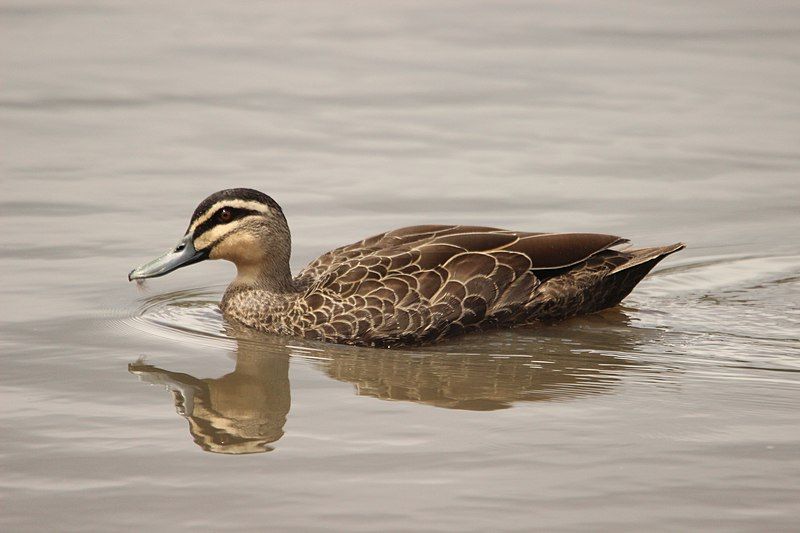
The Pacific black duck, also known as the PBD, is a species of dabbling duck that is found in a range of countries and islands in the Pacific Ocean.
The native range of the duck extends from Indonesia and New Guinea in the west to the Caroline Islands in the north and French Polynesia in the east. In the south, the duck is also found in Australia and New Zealand.
It is an adaptable species of duck, and is found in a variety of habitats from estuaries, wetlands, and rivers to farmlands and urban areas. The Pacific black duck is a medium-sized duck with a body length of around 45-55cm and a wingspan of up to 85cm.
The adult males are generally a dark brown colour, while females are a lighter brown colour. The diet of the duck consists of a variety of plant matter, invertebrates, and small vertebrates. The Pacific black duck is a social species, and can commonly be seen in large flocks.
The ducks are generally monogamous, and form strong pair bonds for the duration of the breeding season. The duck’s nests are usually built close to water, and the female will lay up to 9 eggs.
The duck is considered to be a common species and is not currently threatened with extinction.
| Kingdom | Animalia |
| Phylum | Chordata |
| Class | Aves |
| Order | Anseriformes |
| Family | Anatidae |
| Genus | Anas |
| Species | A. superciliosa |
6. Spotted Whistling duck
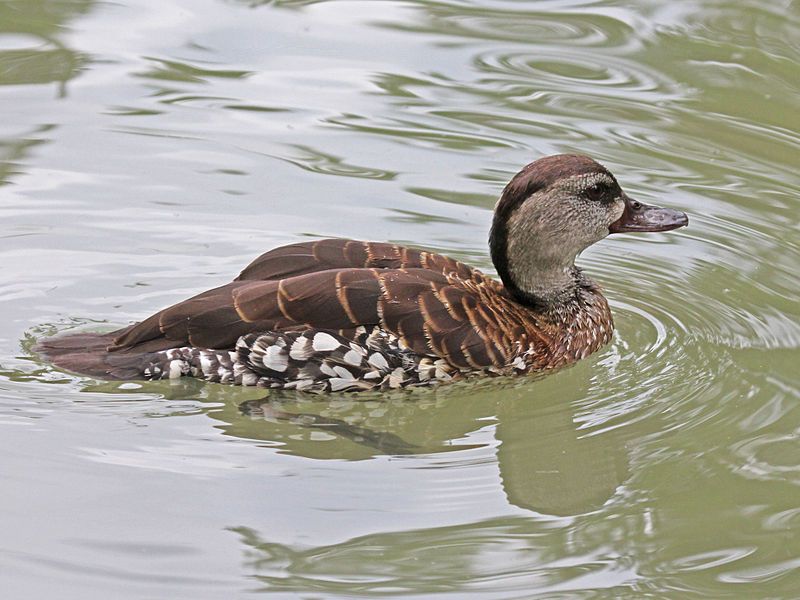
The spotted whistling duck is a species of duck belonging to the family Anatidae. It is also known as the “spotted tree duck” due to its habit of perching in trees.
This duck is native to Indonesia, New Guinea, Australia and the Philippines, but it can also be found in captivity in many other countries. The spotted whistling duck is a medium-sized species, measuring roughly 40 to 45 cm in length.
It has a long, narrow bill and its body is predominantly dark brown in colour, with white spots on its wings and back. Its head is grey and its neck and chest are white.
The spotted whistling duck has a distinctive whistle-like call, which is loud and carries a long distance. The spotted whistling duck is mainly a ground feeder, taking a variety of seeds and invertebrates. It also eats aquatic plants and small fish.
This species is found in wetlands such as marshes, swamps and flooded grassland, as well as in open grasslands, farmlands and urban parks. The spotted whistling duck is a social species and forms large flocks at night.
During the breeding season, the male and female may form pairs, building nests in hollow trees or in dense vegetation.
The female typically lays 6-8 eggs and both parents are involved in incubating and raising the young. The spotted whistling duck is not considered to be threatened in the wild, although its population is decreasing due to human activities such as habitat destruction.
Captive populations are also at risk, as they depend on human care for their survival.
| Kingdom | Animalia |
| Phylum | Chordata |
| Class | Aves |
| Order | Anseriformes |
| Family | Anatidae |
| Genus | Dendrocygna |
| Species | D. guttata |
7. Wandering Whistling Duck
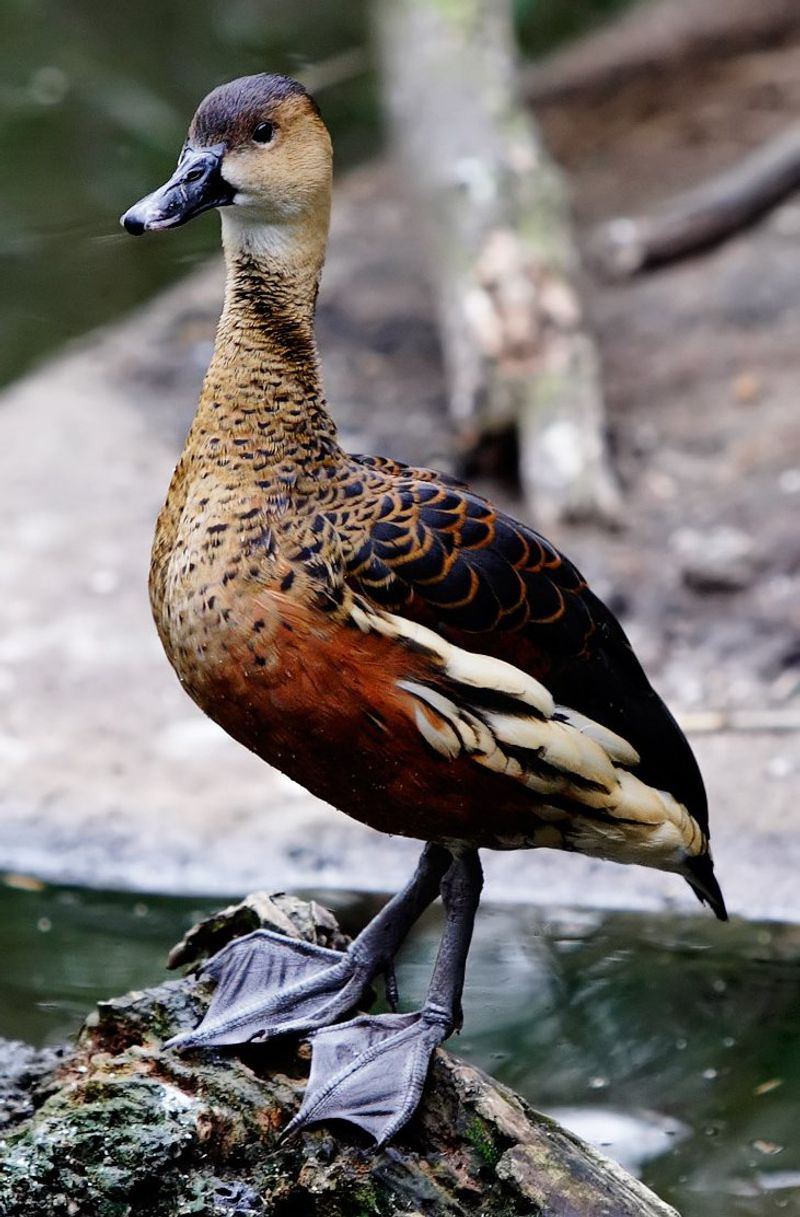
The Wandering Whistling Duck is a species of duck that is found in many tropical and subtropical regions in the world. It is native to Australia, the Philippines, Borneo, Indonesia, Papua New Guinea and the Pacific Islands.
These ducks tend to live in wetlands and are often seen in shallow pools, swamps, estuaries, and flooded grasslands. They are social birds and form large flocks when they are together.
The Wandering Whistling Duck has a unique call which is quite loud and can be heard from a great distance. This call is what gives them their name, as it is a high-pitched, whistling sound. These ducks have an olive-brown colour with a chestnut back and wings.
The males also have a white stripe around their eyes and a white breast. The Wandering Whistling Duck feeds mainly on aquatic vegetation, grasses, and seeds. They are also known to eat insects, molluscs, crustaceans, and small fish.
They forage by dabbling in shallow water or by grazing on land. The Wandering Whistling Duck nests in tree cavities or on the ground near water. The female will lay around 8 to 10 eggs and the young will fledge in about 4 weeks.
These ducks are highly mobile and can migrate over long distances. Overall, the Wandering Whistling Duck is an interesting species of duck that is found in many tropical and subtropical regions. They are social birds, have a unique call, and are quite mobile.
| Kingdom | Animalia |
| Phylum | Chordata |
| Class | Aves |
| Order | Anseriformes |
| Family | Anatidae |
| Genus | Dendrocygna |
| Species | D. arcuata |
8. Gray Teal
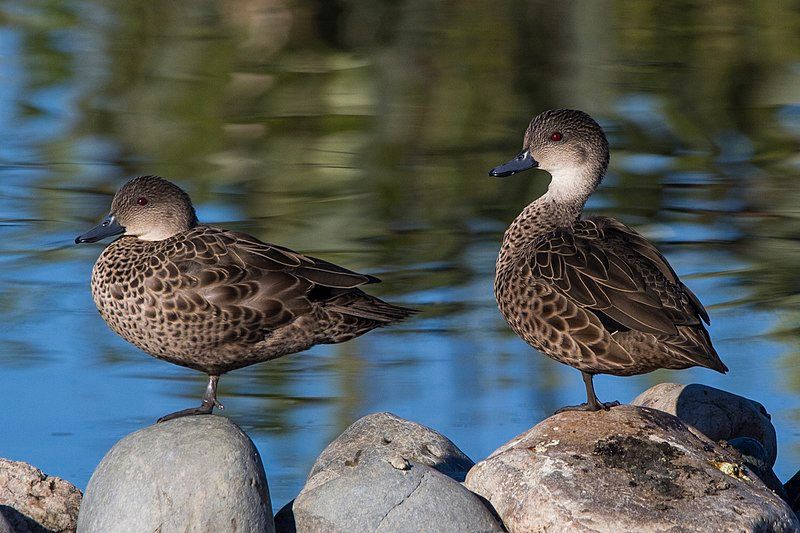
The grey teal is a species of dabbling duck found primarily in Australia and New Zealand. It is a small bird, measuring between 40 and 48 cm in length and weighing between 400 and 500 grams.
The grey teal is easily identifiable due to its slate-grey plumage and distinctive white face. It is typically found in shallow wetlands, swamps, and marshes with ample vegetation, and can also be found along the coast in estuaries and near the sea.
Its diet consists mainly of aquatic vegetation, which it forages in shallow waters or uproots with its bill. It also feeds on insects, mollusks, crustaceans, and small fish. The grey teal is a social bird and breeds in pairs or in small groups.
During the breeding season, the male performs elaborate courtship displays to attract a mate. The pair then builds a nest near a water source, often in a hollow tree or dense vegetation. The male typically incubates the eggs and guards the nest while the female goes off to feed.
The young grey teal fledge after about three weeks, but remain dependent on their parents for another few weeks. The grey teal is an important species for conservation, as it is listed as Near Threatened on the IUCN Red List.
This is due to the destruction of its wetland habitat, as well as hunting pressure and predation. Conservation efforts are underway to protect and restore the species, and the populations of the grey teal are slowly increasing.
| Kingdom | Animalia |
| Phylum | Chordata |
| Class | Aves |
| Order | Anseriformes |
| Family | Anatidae |
| Genus | Anas |
| Species | A. gracilis |
9. Pacific Emerald Dove
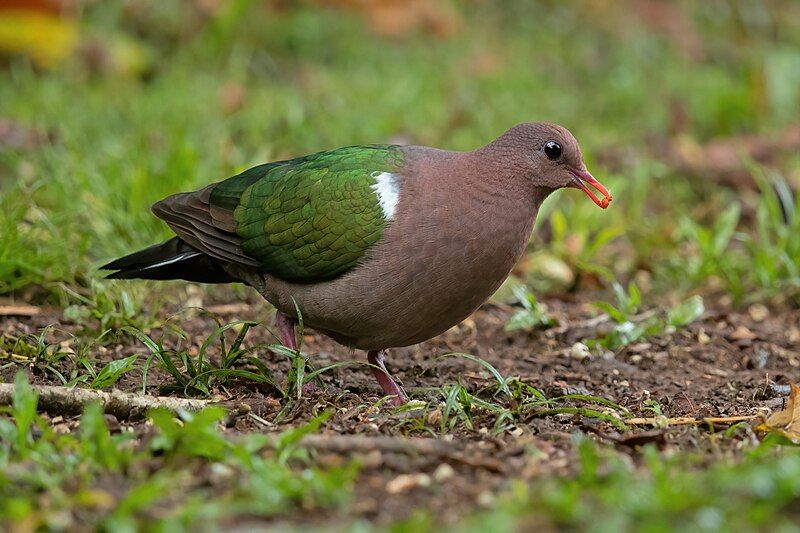
The Pacific emerald dove is a species of pigeon that can be found in a wide range of locations in the tropics and subtropics, from Indonesia to northern and eastern Australia. It is characterized by its brown-capped head, which distinguishes it from other species.
In the past, it was classified together with the common emerald dove, but it is now considered to be a distinct species due to its unique physical features and distinct habitat range.
The Pacific emerald dove is a widespread resident breeding bird that can be seen throughout its range. It is an ecologically important species, as it serves an essential role in the local food chain, providing food for various predators.
It is also an important source of seed dispersal, helping to maintain the health of local ecosystems.
| Kingdom | Animalia |
| Phylum | Chordata |
| Class | Aves |
| Order | Columbiformes |
| Family | Columbidae |
| Genus | Chalcophaps |
| Species | C. longirostris |
10. Black-Naped Fruit Dove
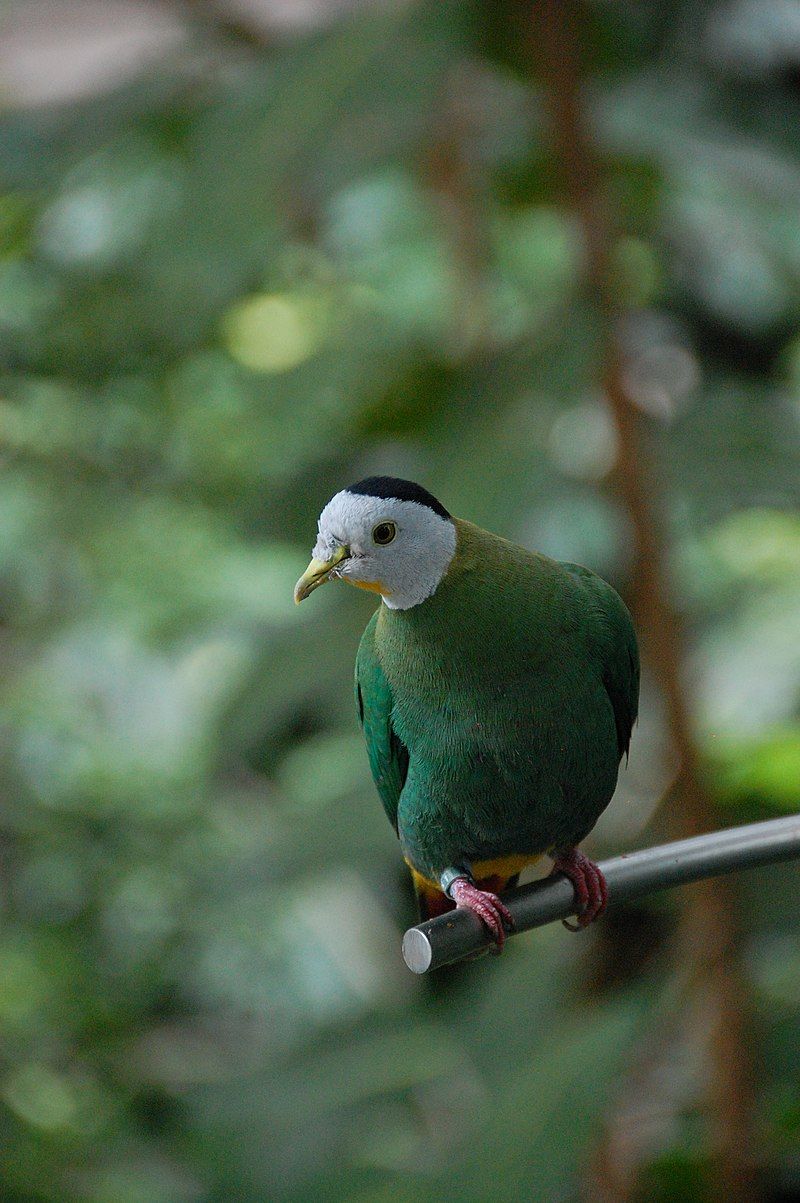
The black-naped fruit dove is a species of green fruit dove that is characterized by its medium size and distinctive head markings. It reaches up to 24 cm in length and has a yellowish bill and iris.
The male bird has a pale gray head with a black nape, yellow throat, and golden yellow and pink undertail coverts. This species of fruit dove is sometimes known as the black-headed fruit dove due to its unique head markings.
The black nape is the most recognizable feature of the male bird, which helps differentiate it from other species of green fruit dove. The yellow throat and golden yellow and pink undertail coverts further add to the bird’s distinct appearance.
The black-naped fruit dove is a stunning species that is sure to captivate birdwatchers and nature enthusiasts alike.
| Kingdom | Animalia |
| Phylum | Chordata |
| Class | Aves |
| Order | Columbiformes |
| Family | Columbidae |
| Genus | Ptilinopus |
| Species | P. melanospilus |
11. Channel-billed Cuckoo
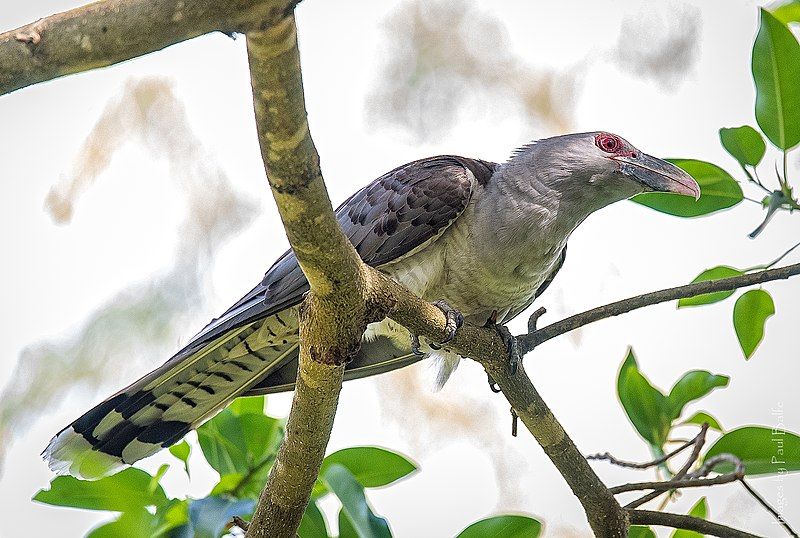
The channel-billed cuckoo is a species of cuckoo that is the only one in the genus Scythrops. It is known for being the largest cuckoo and the largest brood parasite in the entire world.
This species is native to Australia, New Guinea, and Indonesia, but may also be found as a vagrant in New Caledonia and New Zealand. The channel-billed cuckoo is a large bird that measures between 45-55 cm in length.
It has a striking, greyish-white head and neck, with black and white bars on its wings. Its tail is white with a black bar at the tip. It has a powerful bill that is yellow-orange in color and has a curved ridge running along the top.
This species feeds mainly on insects, but also eats a variety of fruits and berries. It is usually seen in open woodlands, gardens, and parks. It is a migratory species, and during the breeding season, they will travel to Northern Australia and New Guinea.
The channel-billed cuckoo is a brood parasite, which means that they lay their eggs in the nests of other birds.
The female will lay up to four eggs in the nest of a host species, such as the Australian magpie, and the host species will take care of the eggs and raise the young cuckoos as their own.
The channel-billed cuckoo is an iconic species in Australia and is often referred to as the “Rain Bird” due to the fact that its call is a sign of the wet season arrival. It is also a culturally significant species to some Indigenous Australian groups.
| Kingdom | Animalia |
| Phylum | Chordata |
| Class | Aves |
| Order | Cuculiformes |
| Family | Cuculidae |
| Genus | Scythrops |
| Species | S. novaehollandiae |
12. Large Hawk-Cuckoo
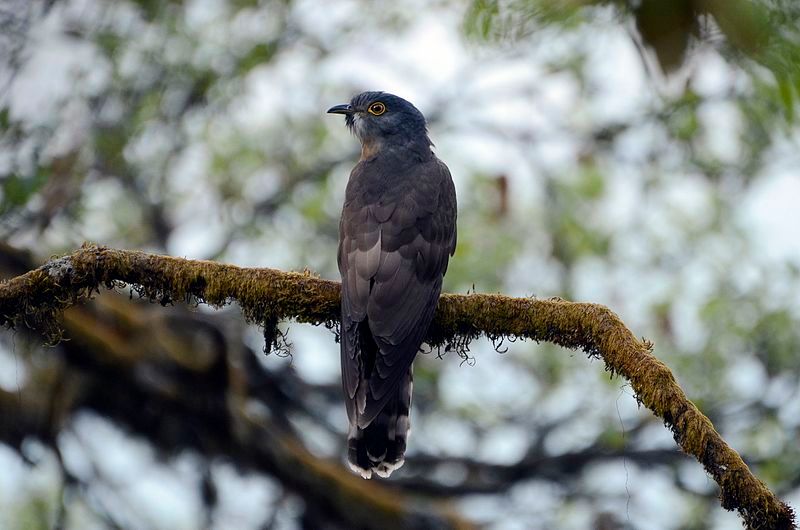
The large hawk-cuckoo is a species of cuckoo belonging to the family Cuculidae. Found across temperate Asia, from the Himalayas to East Asia, the species is widely distributed. During winter, many of its populations migrate further south, in order to find more suitable habitats.
This species of cuckoo is quite unique, as it is the only one with the word “hawk” in its name. In terms of appearance, the large hawk-cuckoo is a medium-sized bird, typically measuring about 32 cm in length.
Its plumage is dark brown on the upperparts, while the underparts are white. It has a crest of feathers on the head, which gives it a hawk-like appearance. In addition, the large hawk-cuckoo has a loud, distinct voice, which is used to attract mates and ward off predators.
| Kingdom | Animalia |
| Phylum | Chordata |
| Class | Aves |
| Order | Cuculiformes |
| Family | Cuculidae |
| Genus | Hierococcyx |
| Species | H. sparverioides |
13. Northern Hawk-Cuckoo
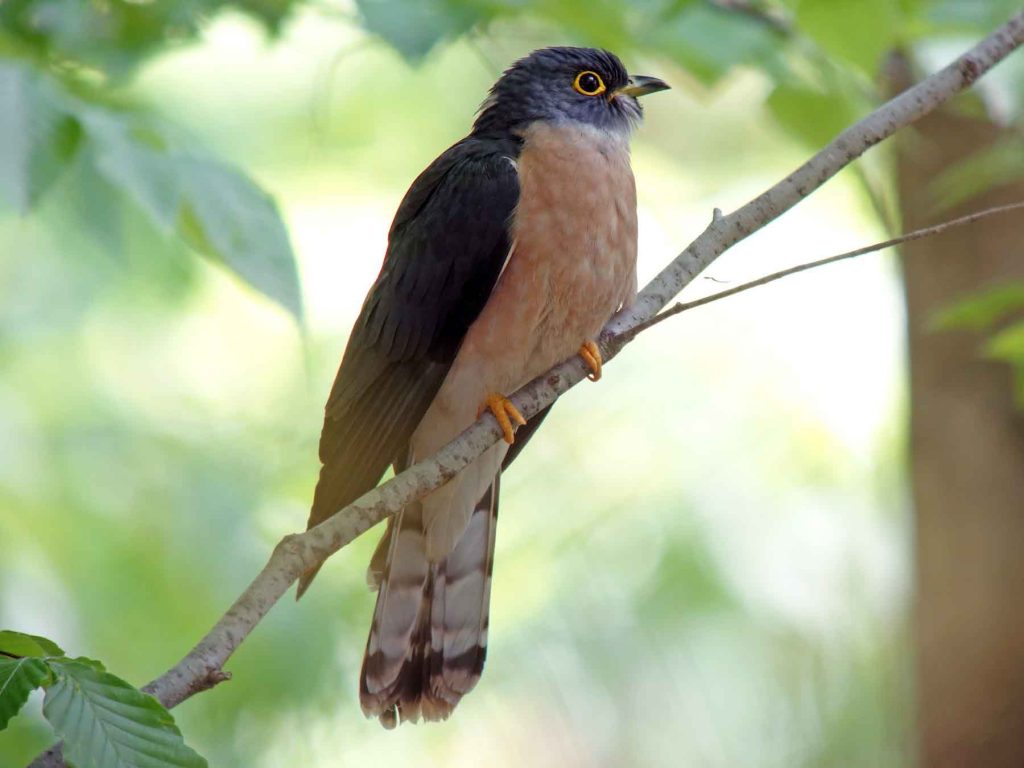
Source: ebird.org
The northern hawk-cuckoo is a bird species belonging to the family Cuculidae, which was previously thought to be the same species as Hodgson’s hawk-cuckoo and classified as part of the genus Cuculus.
This species is mainly found in eastern China, North and South Korea, far eastern Russia, and Japan. During the winter season, northern populations of the northern hawk-cuckoo migrate to Borneo.
The northern hawk-cuckoo is a medium-sized bird, measuring around 22 to 25 cm in length and weighing up to 45 grams. It has a distinctive white belly and chest, with a pale grey head and back. Its wings are grey-brown and its tail is black, with white tips.
They have yellow eyes, a black bill, and strong legs. The northern hawk-cuckoo typically live in deciduous and coniferous forests, as well as in open areas. They feed mainly on insects, such as grasshoppers, caterpillars, beetles, and moths.
They usually hunt by perching on a branch or tree and then swooping down to capture their prey. The northern hawk-cuckoo is a solitary species and usually does not form flocks. They are mainly active during the day and roost in trees at night.
The breeding season usually begins in April or May, and the female builds a nest in a tree or shrub. The female lays up to five eggs and incubates them for around two weeks. The chicks are born with greyish-brown feathers and are able to fly after two weeks.
The northern hawk-cuckoo is a beautiful species that is important for the environment. It helps to control insect populations and plays a role in the food chain.
Although it has a wide range and is not considered to be threatened, it is still important to conserve its habitat and ensure that it does not become endangered.
| Kingdom | Animalia |
| Phylum | Chordata |
| Class | Aves |
| Order | Cuculiformes |
| Family | Cuculidae |
| Genus | Hierococcyx |
| Species | H. hyperythrus |
14. Pacific Koel
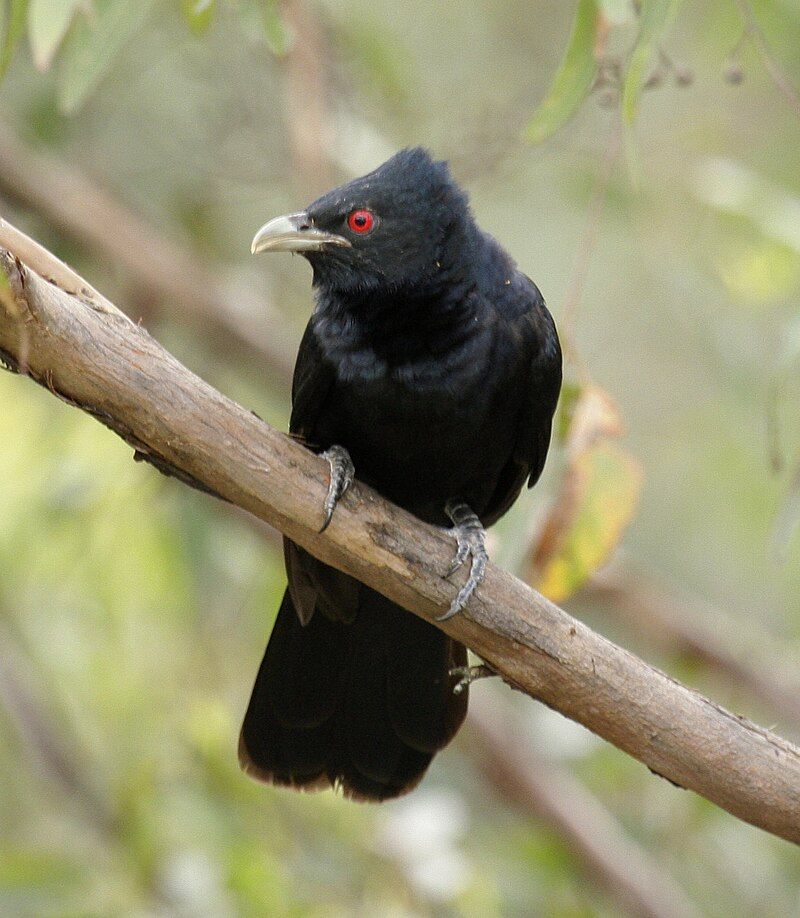
The Pacific koel is a species of bird belonging to the family Cuculidae. It is native to several countries in the Pacific region, including Australia, New Zealand, China, and Japan. It is also known as the eastern koel or formerly common koel.
In Australia, it is widely known as the rainbird or stormbird due to its call being especially common before or during stormy weather.
Its call has a distinctive sound that is mostly heard during the summer months and is often described as a loud, high-pitched, and repetitive “kee-ow” or “kee-wah” sound. The Pacific koel is an evergreen bird that is mostly found in woodlands and gardens.
It has a long, slender body with a long tail and grey-brown plumage. Its distinctive black face and yellow eyes make it easy to identify. It feeds mostly on insects, berries, and other fruits. It is an important species for controlling pest populations.
The Pacific koel is a migratory bird, with some birds traveling as far as the Philippines and Indonesia.
| Kingdom | Animalia |
| Phylum | Chordata |
| Class | Aves |
| Order | Cuculiformes |
| Family | Cuculidae |
| Genus | Eudynamys |
| Species | E. orientalis |
15. White-Bellied Imperial Pigeon
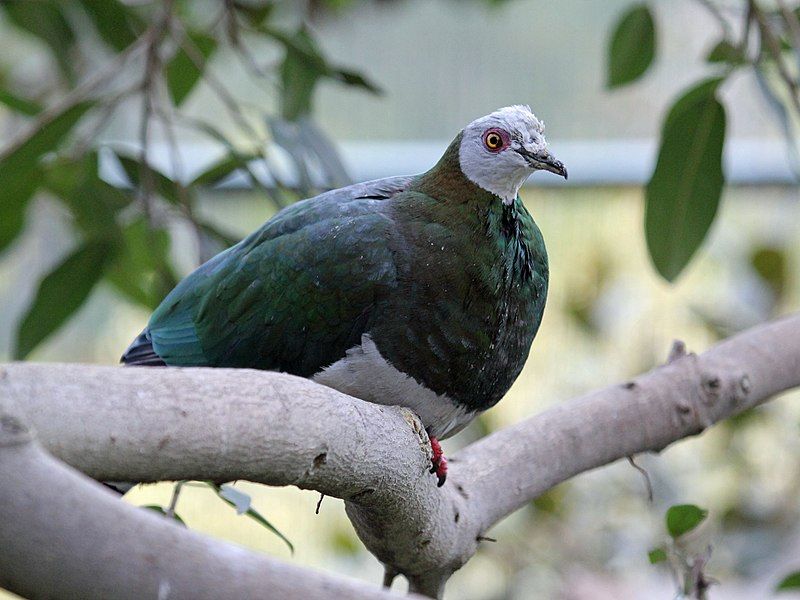
The White-bellied Imperial Pigeon is a species of bird that belongs to the Columbidae family. It was first described by the French ornithologist Charles Lucien Bonaparte in 1854 and is only found in Indonesia.
This species of bird is endemic to the area, meaning it is native to the region and found nowhere else in the world. In Indonesia, it can be found on Sulawesi, Buton, Taliabu, Togian, and Peleng.
The White-bellied Imperial Pigeon is a medium-sized bird with a white belly and grey head and wings. They have a distinctive red wattle on their neck and a long tail. The bird has a loud, cooing call that can be heard up to a mile away.
They typically live in lowland forests and feed on fruits, nuts, and seeds. They are usually seen in pairs or small groups and are quite shy. The White-bellied Imperial Pigeon is considered to be a vulnerable species due to the destruction of its habitat.
The bird is also hunted for food by local people, putting further pressure on the population. Conservation efforts are underway to protect this species and its habitat.
Public awareness campaigns are also helping to educate people about the importance of protecting this species.
| Kingdom | Animalia |
| Phylum | Chordata |
| Class | Aves |
| Order | Columbiformes |
| Family | Columbidae |
| Genus | Ducula |
| Species | D. forsteni |
16. White-Throated Needletail
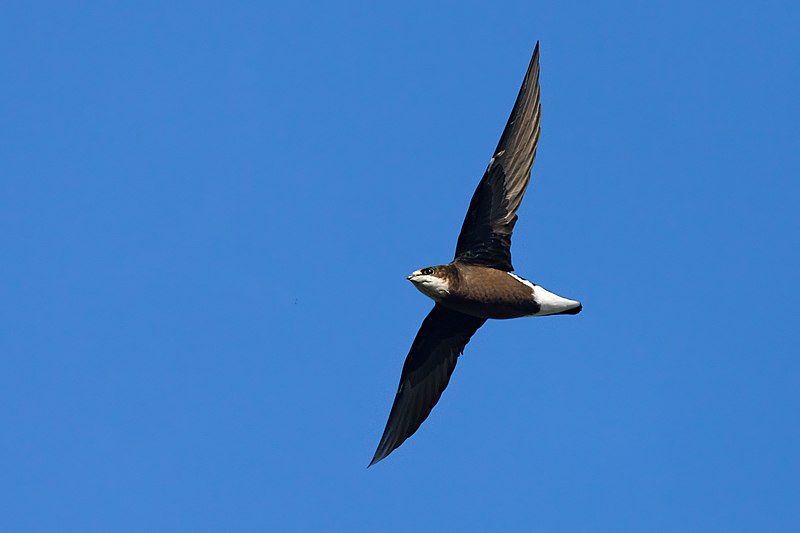
The white-throated needletail is a species of large swift that belongs to the genus Hirundapus. It has a distinctive white throat, as well as a long, pointed tail which gives it the name of needle-tailed swift or spine-tailed swift.
It is believed to be able to reach incredible speeds of up to 170 km/h in horizontal flight, however, there is no way to verify this due to the fact that the methods used to measure its speed have not been made public.
This incredible speed is likely due to its streamlined, aerodynamic body as well as its powerful wings. While it is uncertain what the true speed of the white-throated needletail is, it is undeniable that it is an incredibly fast bird!
| Kingdom | Animalia |
| Phylum | Chordata |
| Class | Aves |
| Clade | Strisores |
| Order | Apodiformes |
| Family | Apodidae |
| Genus | Hirundapus |
| Species | H. caudacutus |
17. Yellow-Billed Malkoha
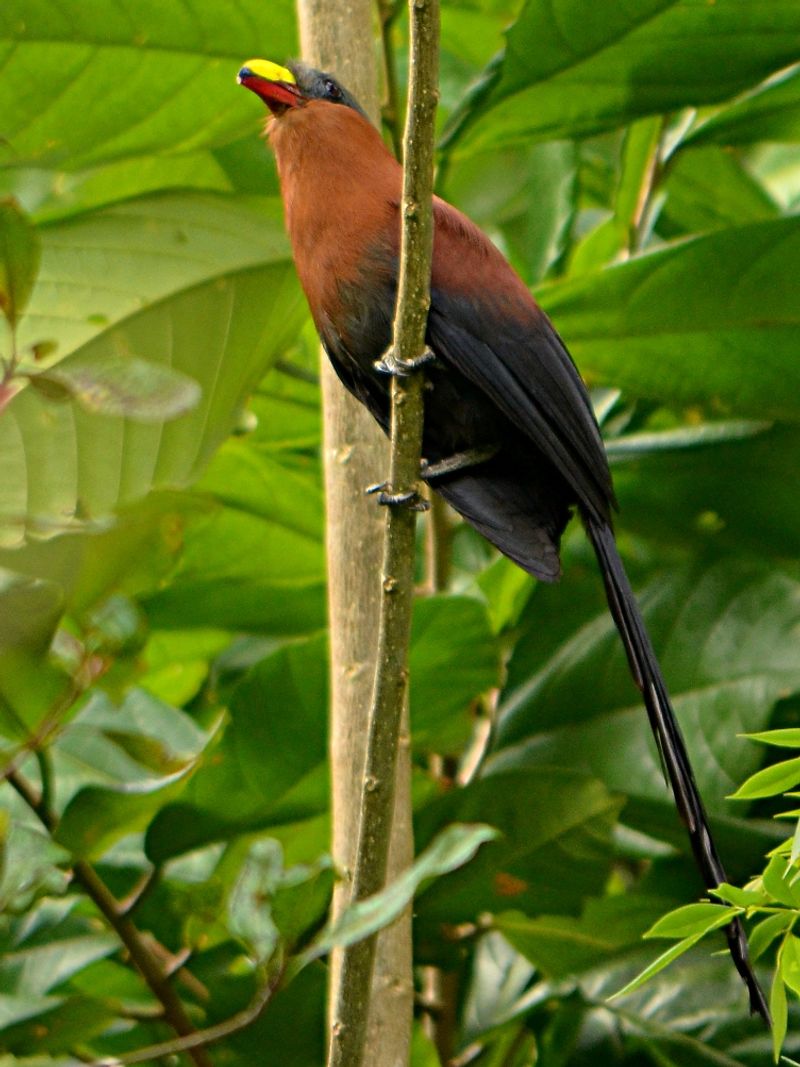
The yellow-billed malkoha is a unique species of cuckoo belonging to the family Cuculidae. It has only been found in Sulawesi, an island in Indonesia, and is not known to exist anywhere else.
This species prefers to inhabit subtropical or tropical lowland forests with moist conditions. The yellow-billed malkoha has a distinct appearance, with its yellow bill and distinguishing call that can be heard in the forests.
It is a medium-sized bird, measuring about 30 cm in length and weighing around 100 to 120 grams.
The wingspan of this species is around 45 cm and they have a yellowish brown plumage. The yellow-billed malkoha is mainly active during the day, and it feeds on insects, fruits and small reptiles.
It usually forages in pairs or small groups and is known to be quite shy and wary of humans. It typically roosts in small trees or bushes, and nests near the ground in dense vegetation.
This species is classified as Near Threatened by the IUCN, due to habitat loss and fragmentation caused by deforestation and urbanization. Conservation efforts are needed to ensure its long-term survival.
| Kingdom | Animalia |
| Phylum | Chordata |
| Class | Aves |
| Order | Cuculiformes |
| Family | Cuculidae |
| Genus | Rhamphococcyx |
| Species | R. calyorhynchus |
Conclusion
Birds in Gorontalo are an important part of the local ecosystem. They provide food for other animals, pollinate plants, and maintain the health of the local environment. They also provide a source of entertainment and beauty to the people of Gorontalo.
Their diverse range of species makes them a fascinating group of animals to observe and appreciate. Conservation of their habitats is essential to ensure the continued presence of birds in Gorontalo.